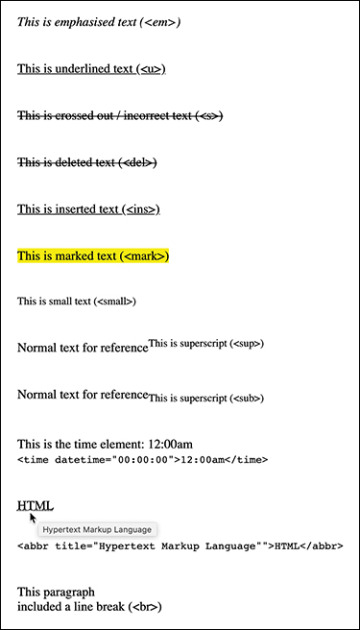- HTML Text Formatting
- Paragraphs and Headings
- Lists
- Quoting a Block of Text
- Formatting Text Inline
- Marking Up Code
- Wrapping Up
Formatting Text Inline
The last of the basic elements we’ll cover are inline elements—that is, elements that are used inside other elements.
Paragraphs, headings, and lists are “block-level” elements. They are self-contained sections that start on a new line and take up the entire width of the container. But inline elements do not start on a new line and are only as wide as the content. An example is the <strong> tag.
In the following task you'll create a short paragraph (a block element) and change the formatting of some of the text in the middle of it (an inline element).
To bold text with the <strong> tag:
Type <p>We use the strong tag to.
Type <strong>draw attention</strong>.
Type to text by bolding it.</p>.
You can see the result in FIGURE 4.5.

FIGURE 4.5 The paragraph produced by the code in this example
Notice that the <strong> tag is inside the <p> tag but still inline with the text. And by default, the browser bolds <strong> text. However, there’s another benefit to using the <strong> tag. It tells browsers and search engines that this text is slightly more important than the normally formatted text.
The catalog of tags for formatting inline text is extensive; here are the most common ones (FIGURE 4.6):
<em> is used for emphasis. It shows as italicized text. Use the <i> tag if you want to set the text apart without semantically noting “emphasis.”
<u> is used to underline text. It shows as text with a line drawn under it.
<s> is used to cross something out because it is no longer correct. It shows as text with a line through it. You may also come across <strike> in older code, but it’s now been replaced by <s>.
<del> looks similar to <s>, but lends a slightly different meaning to text. <del> marks something that has been deleted from the original document.
<ins>, which is usually underlined by default, notes something that has been inserted into the document.
<mark> is used to highlight text. It adds a yellow background to text, as if a highlighter pen has been drawn across it.
<small>, which renders text smaller than the default size, is used for notes, side comments, and fine print.
<sup> is superscript, and makes text appear smaller and raised slightly above the baseline. This is often used for exponents, or bibliographic citations.
<sub> is used to display subscript text. Like <sup> reduces text size but is lowered below the baseline than normal text.
<time> represents a specific time and is often combined with the datetime attribute to convert human readable time into a machine-readable format.
You’ll find a list of valid datetime values here: developer.mozilla.org/en-US/docs/Web/HTML/Element/time.
<abbr> represents an abbreviation and is usually rendered with a dotted underline. You can include the fully expanded version of the abbreviation in the title attribute, which is usually displayed in a tooltip on mouseover.
<br> creates a line break. It’s useful for situations when you want to make lines a specific length, as in poetry or in a mailing address.

FIGURE 4.6 All of the listed formatting markup and their default styles in Chrome.

 VIDEO 4.5: Converting a Fully Formatted Word Doc to HTML
VIDEO 4.5: Converting a Fully Formatted Word Doc to HTML